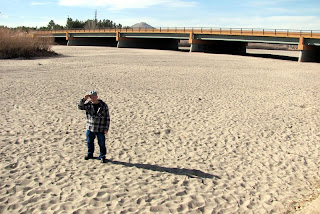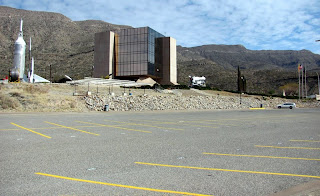We visited the Rio Grande, which flows through Las Cruces, and found it wasn't flowing at all.
Dinah, Dave, and I had dinner with Jeanette Fisher, and Lee & Marsha Squires; RVing friends who were in town for a Habitat for Humanity build.
We visited the New Mexico Space Museum in Alamogordo and had the place pretty much to ourselves - you can see our car is the only one in the parking lot!
Here is Dave with one of the world's largest rocket engines outside the museum.
We checked out Spaceport America located about 50 miles north of Las Cruces. The building in the background is the futuristic-ly shaped terminal. Spaceport is still under construction, and we weren't allowed any closer than the picture shows.
When Dinah went to the dentist in Palomas, Mexico, we tagged along as far as Deming, NM where we visited the Luna Mimbres Museum with collections galore and something to entertain and to bore everybody.
Here is a poster of one of our childhood heroes - in French.
This display taught me that there was a Destroyer USS Downes (DD-375) that was damaged during the Japanese raid against Pear Harbor. It was named for a Massachusetts Man, Commodore John Downes, born in Canton, MA but probably not related (as he spells Downes with an e).
Our final trip was to Columbus, NM to visit the Railroad Depot Museum. Pancho Villa led a raid here in March, 1916. As a result, the local military base was enlarged to the point that Columbus had the largest population of any city in New Mexico. The first US airbase was established with the United States' entire fleet of 8 aircraft.
Columbus is now a sleepy town. The railroad is long gone along with the military base. But the train station remains and is now a museum featuring local history which of course includes the railroad and the Pancho Villa raid.
The switchboard in this picture was in use in Columbus at the time of the raid.
Although the railroad is gone, and there is no sign of the old tracks, the museum has reconstructed a few feet of track to put a caboose on. And here is Dave waving goodbye at the end of his New Mexico visit.














